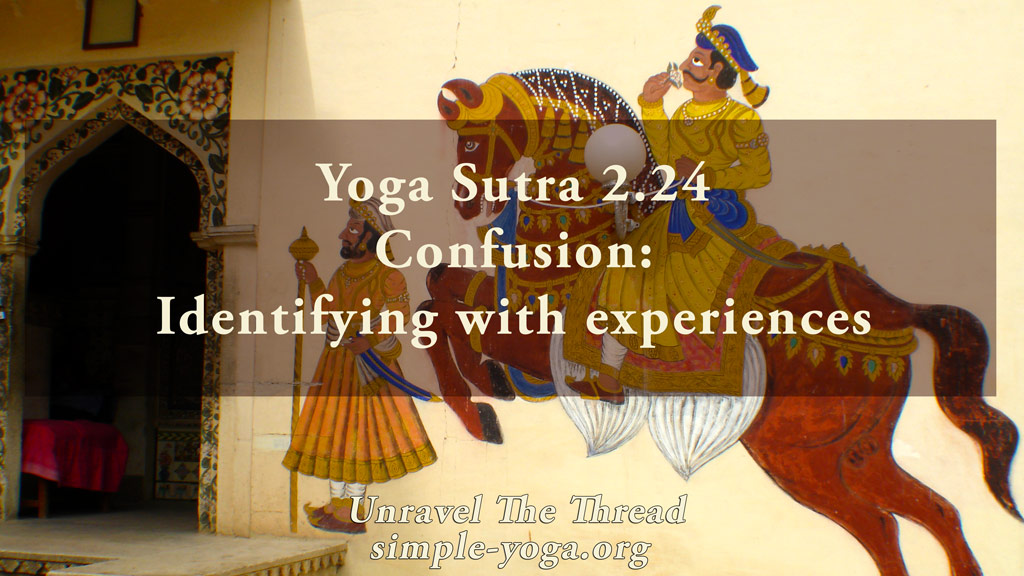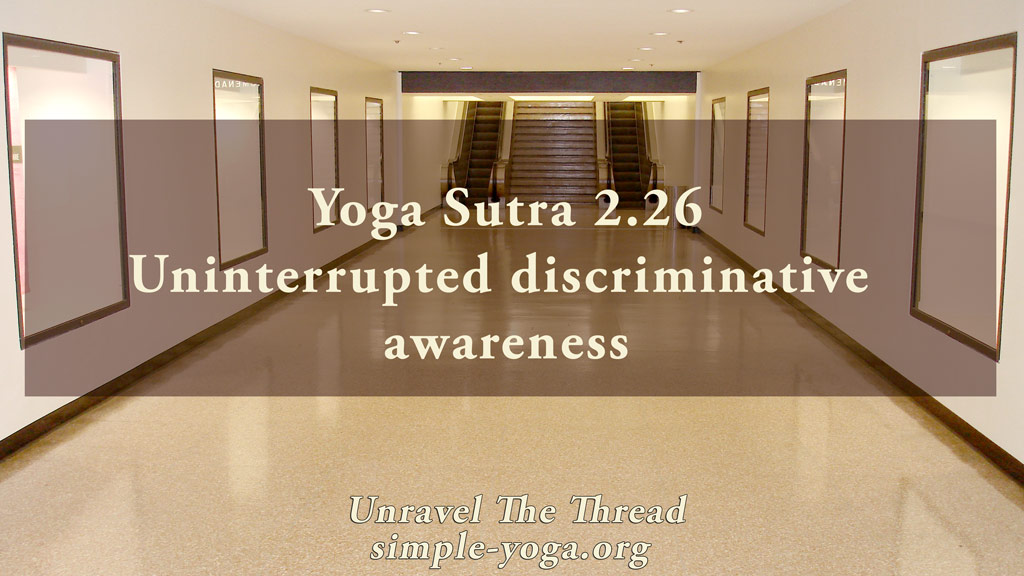
2.24 Identifying with experiences is confusion
August 4, 2020
2.26 Uninterrupted discriminative awareness
August 15, 2020
2.24 Identifying with experiences is confusion
August 4, 2020
2.26 Uninterrupted discriminative awareness
August 15, 20202.25 Freedom by removing confusion

2.25 Freedom arises from removing confusion.
Up until this point in this chapter Patañjali has explained yogic action as a way to decrease afflictions, describing the afflictions and their effects and the relationship between awareness and experiences. Now, Patañjali presents the goal of yoga practice, liberation from afflictions and suffering.
Consciousness is the power of seeing, or the knowing that enables you to be aware. Consequently, you witness the changing phenomena in nature. Consciousness underlies every one of your states, actions and experiences. Life is what can be experienced and perceived, as well as the continuous stream of unpredictable changes taking place. Life and consciousness are not in conflict or opposition. On the contrary, life and consciousness complement one another. One traditional example for these interactions is that of the reflection of the full moon on the surface of a still lake, when it may seem like the moon is part of the lake. When there is agitation in the water, however, you cannot see the reflection of the moon, but the moon does not disappear. Similarly, when your activities, your ways of being, occupy all of your internal environment, it may seem that there is no consciousness because your awareness is completely entangled in your experiences. Yet, when the storms of internal agitation recede, the calmness within is more noticeable. Confusion and suffering arise from misidentification and when such misidentification is removed there is freedom.
One practical way of understanding the complementarity and interaction between life and consciousness is to think of life as doing and of consciousness as being. At a very basic level, you are in a constant process of negotiating between your outward orientation and your inward orientation. For example, when you notice a fragrance in the air (external) it may trigger a memory linked to that aroma (internal). You may try and smell more intently and to locate where the smell is coming from (external), by walking around and looking as you breathe deeper. This may bring your awareness to a memory (internal) of a place that you used to frequent, or a garden you visited often during your childhood. These thoughts can, in turn, bring back other memories and emotions that may have been dormant for a long time. All these activities, internal and external, are temporary experiences. You can be present in all these parts of your life thanks to awareness. Indeed, your awareness enables you to notice some aspect of you smelling, remembering, feeling, walking and searching – internally, for memories, and externally, for the source of that fragrance. You can become so absorbed in this process that you may not even notice that you are about to step in a puddle of water. Depending on your mood, stepping in a puddle of water may make you upset or angry; or you may not care at all because you are fascinated by the scent you are trying to identify.
Life is made up of all the internal and external experiences you have, and consciousness is the space where all of it takes place with awareness being the active aspect of consciousness enabling you to experience it all. Confusion is the result of mistakenly identifying with your changing experiences – and forgetting that consciousness is always there for you, underlying every experience, making it possible to be present in your life. Not recognizing the distinction between these interrelated aspects of you tends to cause identification with the experiences which leads to the suffering resulting from the five afflictions presented at the beginning of this chapter. In your daily activities, is your tendency to identify more with the sensations, or with the witnessing awareness? Does this vary according to what you are doing? What can you surmise from these observations? Do you notice patterns, tendencies and biases? Are they conducive to feeling free, or restricted? Are your ways of moving and breathing restrictive, or liberating? Are your opinions, beliefs and memories sources of restrictions, or freedom? Are your interactions informed by your awareness or by your experiences?
As usual, one more way of exploring the meaning of this sutra is by chanting it.
You can choose to chant it in its traditional form with some of the words coming together:
2.25 tadabhāvātsaṃyogābhāvo hānaṃ taddṛśeḥ kaivalyam
तदभावात्संयोगाभावो हानं तद्दृशेः कैवल्यम् ॥२५॥
Another option is to chant each word in the sutra individually:
- tat
- abhāvāt
- saṃyoga
- abhāvaḥ
- hānaṃ
- tat
- dṛśeḥ
- kaivalyam
If you prefer, you may listen to the podcast:
Unravel the thread is now available as a book!
If you find Simple-Yoga.org and Unravel the thread useful, consider supporting my labor with a donation, you may also donate using PayPal or Venmo. Thank you!
